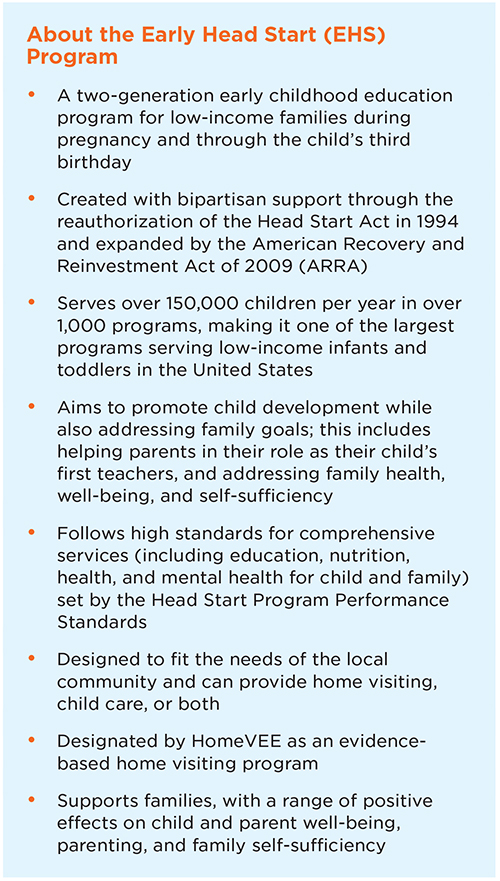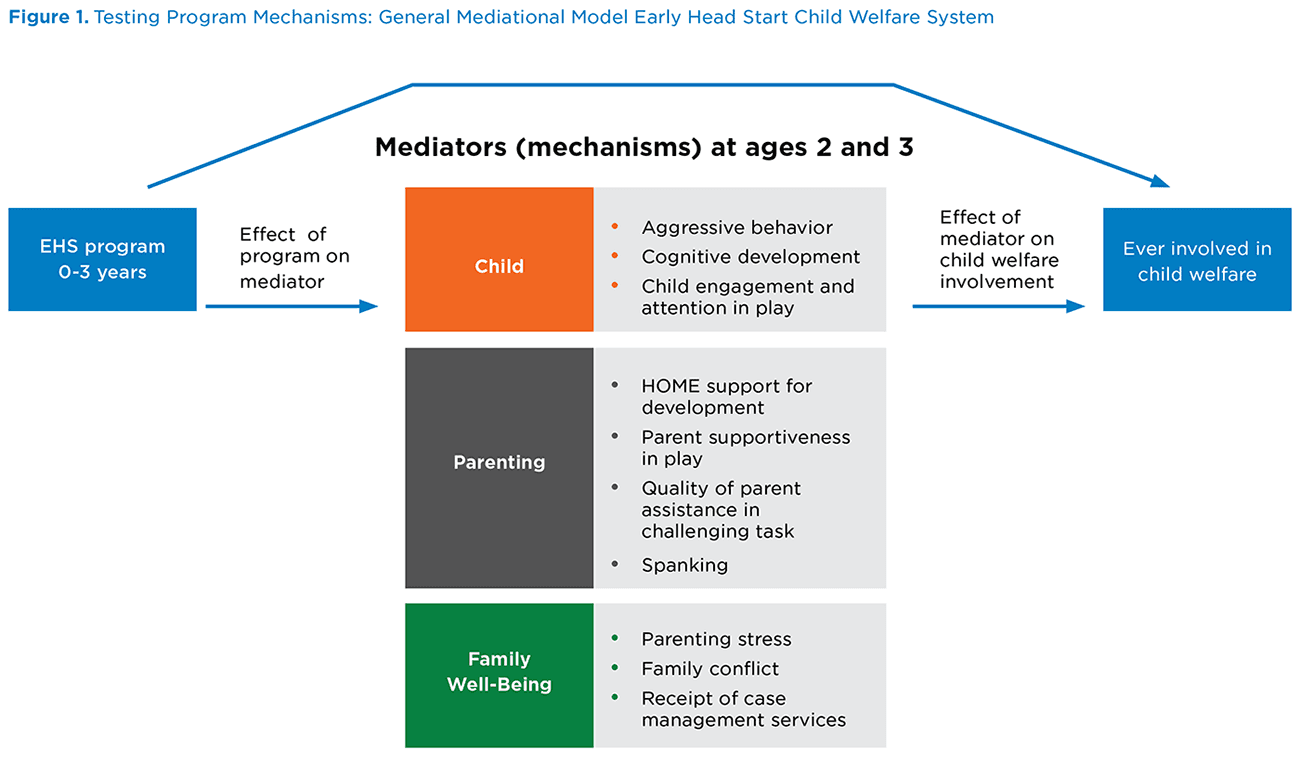Documenting and understanding the long-term impact of early childhood programs on child and family well-being, particularly on child abuse and neglect, is a challenge. Programs that serve families with infants and toddlers, such as Early Head Start (EHS), typically strive for positive outcomes while children are enrolled in the program, but also after they have left. Unfortunately, most research on programs for infants and toddlers focuses exclusively on immediate impacts on child development, school readiness, and family functioning without follow-up over time to understand their longer-term well-being.
Even fewer studies identify short-term positive changes that create a pathway toward later benefits for children and families. Identifying these changes is critical, especially for young children at high risk for serious adversities such as child abuse and neglect and poverty. By identifying short-term program outcomes that lead to long-term outcomes, we can clarify which family-, parent-, and child-level factors are most important for ensuring children’s resilience to adversity.

Early childhood programs have been shown to have long-term benefits for infants, toddlers, families, and society; some have been found to prevent child abuse and neglect. One study found that EHS held promise as a child abuse and neglect prevention program, although (as with many other early childhood programs) addressing child maltreatment is not an explicit program goal.
This research-to-practice brief summarizes findings from a large-scale study on the role of EHS in reducing child abuse and neglect. The study team included researchers from Portland State University, Brazelton Touchpoints Center, Child Trends, and Tufts University. We also provide recommendations for early childhood practitioners to strengthen services for infants and toddlers and to help prevent child abuse and neglect.
The Current Study
This longitudinal study of the long-term benefits of EHS examined program impacts on child maltreatment, and on short-term child, parent, and family outcomes that are linked to longer-term child outcomes. We went beyond simply asking, “Did the program work?” and asked, “How did it work?” to prevent child abuse and neglect, also referred to as child maltreatment, among children, birth to age 16.
To conduct the study, we:
- Collected state child welfare agency records, for a period of 16 years (1997–2013), of substantiated (confirmed) maltreatment reports and other child welfare involvement for 2,794 children (1,414 in EHS and 1,380 in the control group) from 16 of the 17 EHS sites in the original randomized controlled trial (RCT) of EHS. These 16 EHS sites were located in 15 racially, linguistically, and geographically diverse communities.
- Linked child maltreatment records to data from the original RCT, which includes comprehensive information about children, parents, and families collected from when children were approximately one year old through grade 5.
- Examined EHS program impacts on child maltreatment and other key early outcomes for children and parents that led to later effects on child maltreatment. That is, we studied whether EHS prevented children’s involvement with the child welfare system from birth to age 15, and if so, what factors might explain how the program was able to have this impact.

Study Results
Results from this study found the following:
Incidence of child maltreatment
- 504 children (18%) involved in the study had either a substantiated child welfare report and/or an out-of-home placement.
- Seventy-three percent (73%) of substantiated reports involved child neglect, 30 percent involved physical abuse, and 20 percent involved sexual abuse (more than one type of maltreatment was possible for each report).
Preventing child maltreatment
- Participation in EHS led to a long-term reduction in the likelihood that children were involved with the child welfare system, driven by earlier program impacts on parenting and child development. Statistics indicate that the magnitude of these effects are relatively small, which is not surprising given the variation in child welfare systems, reporting norms, and community services across the 15 states.
- Among children age 2 and their families, families who participated in EHS had better parenting and family outcomes compared to those in the control group. The following program impacts led, in turn, to reductions in child maltreatment:
- Greater parental emotional responsiveness, warmth, and supportiveness
- Lower levels of parenting stress
- Less family conflict
- Among children age 3 and their families, those who participated in EHS had better parenting and child development outcomes than those in the control group. The following short-term outcomes, in turn, led to reductions in child maltreatment, including:
- Greater parent supportiveness
- More supportive home environments
- Improved cognitive development, engagement and attention during play
- Among children age 2 and their families, families who participated in EHS had better parenting and family outcomes compared to those in the control group. The following program impacts led, in turn, to reductions in child maltreatment:
Specific pathways at age 3
- Children enrolled in EHS, who had better cognitive development and higher levels of engagement and attention during play with their parent, were less likely to become involved later in life with the child welfare system than children in the control group.
- Parents involved in EHS were more supportive of their children compared to children in the control group, which in turn led to less child maltreatment.
- Parents involved in EHS provided more supportive home environments than their control group counterparts, which in turn reduced the likelihood of subsequent child maltreatment.
- The EHS program’s impact on these outcomes at age 3 was a key mechanism for longer-term maltreatment prevention. Children participating in EHS showed significant improvements; for example, they were 10 to 22 percent less likely to be involved with the child welfare system.
The study team also examined additional program outcomes, including increased knowledge of infant development, reduced use of corporal punishment, and improved family economic stability. While these are important program outcomes for other reasons, they did not lead to later reductions in maltreatment.
Implications for Policy, Practice and Research
Overall results from this study show that EHS can effectively reduce child abuse and neglect after services end. Specifically, EHS led to positive short-term outcomes among participating families that, in turn, led to reduced chances of child welfare involvement. In particular, children were at lower risk for abuse and neglect later in life when EHS was successful in:
- Reducing levels of family conflict and parenting-related stress
- Supporting emotionally warm, engaged, and responsive parenting practices
- Promoting child cognitive development and self-regulation skills
Study findings demonstrate that two-generation early childhood education programs such as EHS can play an important role in preventing child maltreatment. Programs that successfully decrease family conflict and stress in a child’s early years while simultaneously supporting positive, emotionally responsive parenting and child cognitive development are more likely to reduce the likelihood of abuse and neglect after the program ends.
These findings underscore the potential for programs serving infants and toddlers to improve critical long-term outcomes for children by connecting with and supporting parents and families—even if preventing child maltreatment is not an explicit goal.
Moreover, this study highlights the importance of conducting longitudinal follow-up studies to assess long-term impacts of early childhood programs. It also demonstrates the importance of looking at mechanisms of change to inform what outcomes programs should emphasize. Studies that focus solely on outcomes, without attending to key mechanisms of change, are likely to miss important lessons about how these programs create foundations for positive change. Future research can also examine whether the provision of additional supports for programs to strengthen impacts on the mechanisms identified in this work increases their success in preventing maltreatment.
The EHS program—one of the largest federally funded programs for infants and toddlers in the United States—is currently only funded to serve a very small percentage of eligible families. Increasing access to these effective programs represents a key pathway for attaining more significant population-level reductions in child abuse and neglect. Furthermore, these findings offer evidence of the importance of supporting a two-generation approach to early education programs: It is clear that the impact of EHS on parent well-being and parenting skills helped reduce the risk for later child maltreatment.
Click here to download the PDF
Authors
Beth L. Green, Center for the Improvement of Child and Family Studies, Portland State University, Portland, OR
Catherine Ayoub, Brazelton Touchpoints Center, Boston Children’s Hospital, Harvard Medical School, Boston, MA
Jessica Dym Bartlett, Child Trends, Bethesda, MD
Carrie Furrer, Center for the Improvement of Child and Family Studies, Portland State University, Portland, OR
Rachel Chazan Cohen, Child Trends, Bethesda, MD; Tufts University, Medford, MA
Katherine Buttita, Brazelton Touchpoints Center, Boston Children’s Hospital, Boston, MA
Adam Von Ende, Brazelton Touchpoints Center, Boston Children’s Hospital, Boston, MA
Andrew Koepp, Brazelton Touchpoints Center, Boston Children’s Hospital, Boston, MA
Eric Regalbuto, Brazelton Touchpoints Center, Boston Children’s Hospital, Boston, MA
Mary Beth Sanders, Center for the Improvement of Child and Family Studies, Portland State University, Portland, OR
© Copyright 2025 ChildTrendsPrivacy Statement
Newsletter SignupLinkedInYouTubeBlueskyInstagram